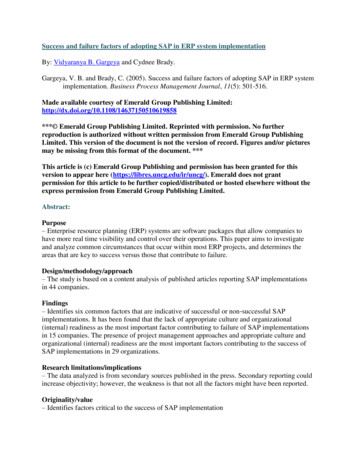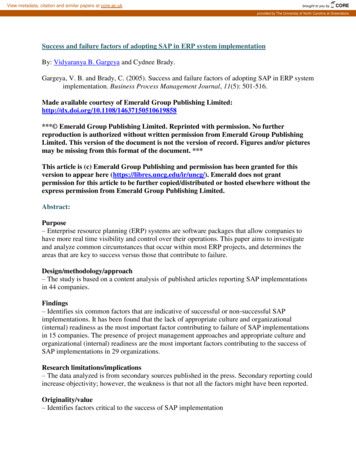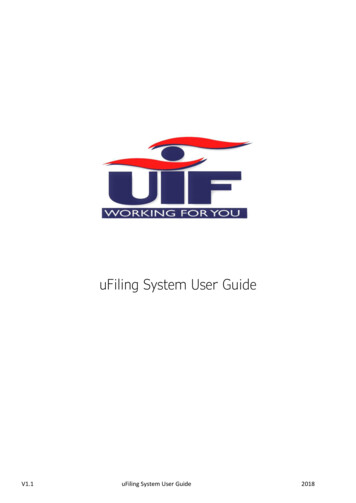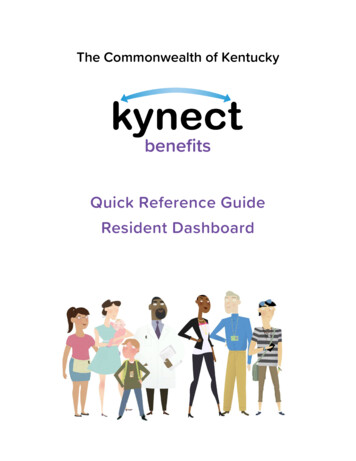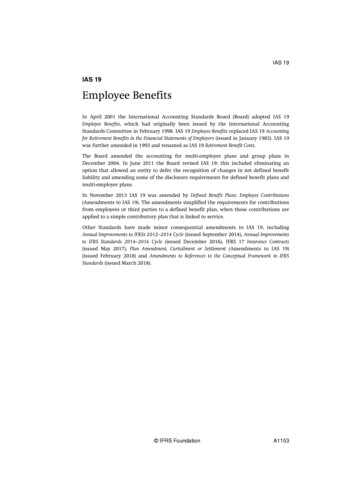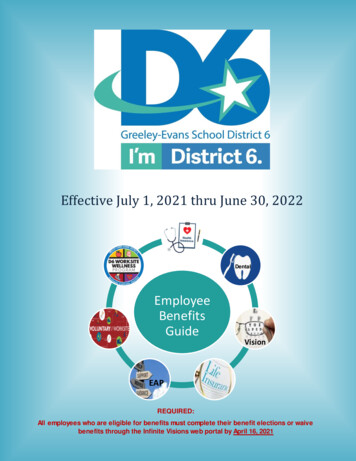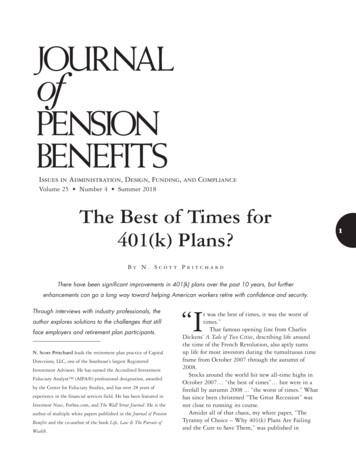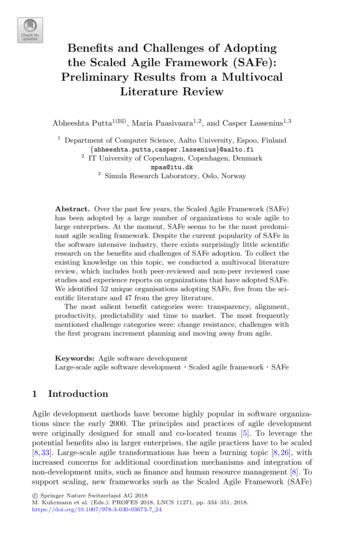
Transcription
Benefits and Challenges of Adoptingthe Scaled Agile Framework (SAFe):Preliminary Results from a MultivocalLiterature ReviewAbheeshta Putta1(B) , Maria Paasivaara1,2 , and Casper Lassenius1,31Department of Computer Science, Aalto University, Espoo, 2IT University of Copenhagen, Copenhagen, Denmarkmpaa@itu.dk3Simula Research Laboratory, Oslo, NorwayAbstract. Over the past few years, the Scaled Agile Framework (SAFe)has been adopted by a large number of organizations to scale agile tolarge enterprises. At the moment, SAFe seems to be the most predominant agile scaling framework. Despite the current popularity of SAFe inthe software intensive industry, there exists surprisingly little scientificresearch on the benefits and challenges of SAFe adoption. To collect theexisting knowledge on this topic, we conducted a multivocal literaturereview, which includes both peer-reviewed and non-peer reviewed casestudies and experience reports on organizations that have adopted SAFe.We identified 52 unique organisations adopting SAFe, five from the scientific literature and 47 from the grey literature.The most salient benefit categories were: transparency, alignment,productivity, predictability and time to market. The most frequentlymentioned challenge categories were: change resistance, challenges withthe first program increment planning and moving away from agile.Keywords: Agile software developmentLarge-scale agile software development · Scaled agile framework1· SAFeIntroductionAgile development methods have become highly popular in software organizations since the early 2000. The principles and practices of agile developmentwere originally designed for small and co-located teams [5]. To leverage thepotential benefits also in larger enterprises, the agile practices have to be scaled[8,33]. Large-scale agile transformations has been a burning topic [8,26], withincreased concerns for additional coordination mechanisms and integration ofnon-development units, such as finance and human resource management [8]. Tosupport scaling, new frameworks such as the Scaled Agile Framework (SAFe)c Springer Nature Switzerland AG 2018 M. Kuhrmann et al. (Eds.): PROFES 2018, LNCS 11271, pp. 334–351, 2018.https://doi.org/10.1007/978-3-030-03673-7 24
Benefits and Challenges of Adopting the Scaled Agile Framework335[25], Large Scale Scrum (LeSS) [24], and Disciplined Agile Delivery (DAD) [3]have been proposed by agile consultants. International workshops on large-scaleagile organized at XP2016 [27] and XP2017 [26] have highlighted the importanceand need for research into the adoption of scaling frameworks [26].According to the 12th State of Agile Survey, which Version One conductsyearly, SAFe continues to be the most popular scaling framework in large enterprises [29]. Moreover, a recent survey on software development approaches indicated the predominance of SAFe over LeSS and DAD [23]. As the number oforganizations adopting scaling frameworks is increasing [29], this provides opportunities for researchers and software practitioners to accumulate knowledge onthe usage of these frameworks through case studies, technical reports and experience reports. To our knowledge, no secondary studies on the benefits and challenges of the scaling frameworks or their adoption process have been published.This is striking, given their importance in the industry. In this paper, we startfilling this gap by summarizing the benefits and challenges of adopting the SAFeframework in the form of a multi-vocal literature review.22.1Related WorkScaled Agile Framework (SAFe)The Scaled Agile Framework was designed by Dean Leffingwell to scale agileto large enterprises [1,36]. It incorporates practices from Scrum, Extreme Programming, Kanban and Lean. It offers four levels: the Team, Program, Portfolioand Value stream levels. The team level comprises the agile teams. Agile ReleaseTrains (ART’s) are introduced to scale a large number of teams and individuals at the program level. ART’s follow HIP (Hardening, Innovation, Planning)iterations to develop Potential Shippable Increments (PSI) or Program Increments (PI). PI’s are planned during the release planning days. SAFe introducesadditional roles such as the Agile Release Train Engineer, system teams, releasemanagement team and portfolio management team. The core values of SAFe are:build in quality, transparency, alignment and program execution [16]. Figure 1gives on overview of the SAFe framework.2.2Secondary Studies on Large-Scale AgileSecondary studies on large-scale agile have explored topics such as challenges andsuccess factors of large-scale agile transformations [8], organizational, managerialand cultural aspects [32], scalability and adoptability [22], inter-team coordination [14], architectural roles [35] and quality requirements practices [2]. However,systematic literature reviews on scaling frameworks have not been found in theliterature. The only review found on scaling frameworks, compares a few scalingframeworks based on team size, practices and organization type [1]. Neither thatreview, nor other previous reviews on large-scale agile have included the grey literature, e.g. case studies or experience reports published on the homepages of
336A. Putta et al.Fig. 1. Scaled agile framework, version 4.5 [19]the frameworks. While there are inherent problems with case studies publishedby the proponents of a particular framework, completely eliminating such studies from literature reviews unnecessarily excludes the voice of the practitionerson the usage of scaling frameworks and implementation of agile at scale. Thus,in particular given the lack of scientific literature, we consider it important tostudy such cases, fully understanding the related problems, further discussedbelow.3Research MethodWe conducted a multivocal literature review on the adoption of the SAFe framework to answer the following research questions:RQ1: What are the reported benefits of adopting SAFe?RQ2: What are the reported challenges of adopting SAFe?3.1Multivocal Literature ReviewSystematic literature reviews and systematic mapping studies have been popularin the field of software engineering. They help to summarize the existing studies
Benefits and Challenges of Adopting the Scaled Agile Framework337reported in a specific research domain [11]. According to the widely adoptedsystematic literature review guidelines [21], a “fully systematic literature review”should include both the grey and the peer reviewed literature. Grey literatureis defined as, “(the literature), produced on all levels of government, academics,business and industry in print and electronic formats, but which is not controlledby commercial publishers, i.e., where publishing is not the primary activity of theproducing body” [11].However, most SLRs published in the software engineering literature havenot included the grey literature [12]. Including the grey literature is challenging,and the search strategy for grey literature has not been systematically addressedin the SLR guidelines [21]. This is unfortunate, as excluding this literature willeliminate the voice and opinions of the practitioners who do not publish in theacademic forums [4,12]. It has been evident that most of the software practitioners do not publish in academic fora [13].The situation seems to be slowly changing for the better. Recent literaturereviews including both peer reviewed literature, as well as grey literature fromblogs, websites, and white papers, have popularized the term “multi-vocal literature reviews”, or MLRs [12]. Several such reviews have been conducted insoftware engineering to bridge the gap between the voice of practitioners andacademics [4,12,28,34].The inclusion of grey literature can also be considered as a threat, as theinformation reported is based on the opinions and experiences of the practitioners rather than systematic data collection procedures and analysis [10]. Thus,there are severe issues with, e.g., author and publication bias that needs to beaccounted for when analyzing such literature. However, several SLRs publishedin the SE literature have already included peer-reviewed experience reports, written by consultants and practitioners, and that rely on experiences rather thansystematic data collection and analysis (e.g., [8,9,31]).Table 1. Search stringsDatabaseSearch strings# matchesScopus(“safe” AND “scrum”) OR “Scaled agile framework” 33Web of science (“safe” AND “scrum”) OR “Scaled agile framework” 16ACM( safe (scrum)) OR “Scaled agile framework”6IEEEXplorer(“safe” AND “scrum”) OR “Scaled agile framework”8Total3.263Study SelectionDatabases: For identifying the peer-reviewed literature we searched scientificdatabases by formulating keywords. The number of matches and the searchstrings are given in Table 1.
338A. Putta et al.The main source for the grey literature was the official SAFe website [19].We included the case studies, including backlinks, published there. We used thissource, as it currently is the most notable source of SAFe studies available. Thecase studies are based on a defined review and data collection procedure. Organizations initially answer a questionnaire [17] and thereafter, the “scaled agileteam” reviews the answers and supplements provided by the organizations. Theteam contacts organizations for interviews with key members responsible during the SAFe implementation to gather background information [18]. Drafts arewritten with the help of case study specialists. These are reviewed and approvedby the organizations before being published on the website. The aim is to publish reports of mature SAFe organizations, i.e., the reports should reflect thesituation no earlier than after 18–24 months into the SAFe implementation [18].The main benefits of this material are the standard format and questionnaireused giving some opportunity for cross-case analysis. However, the review processis likely built not only to guarantee the quality of the published case studies,but also to ensure that the SAFe framework is put in a good light. Therefore,the publication bias is extremely strong, and it can be questioned whether casestudies providing negative results would make it through.Inclusion Criteria: We used the following inclusion criteria:1. Only articles related to the Scaled Agile Framework.2. Only primary evidence: experience reports, case studies, action research.3. Publication type: Conference papers, journal papers, workshop papers, whitepapers from the Scaled Agile Framework’s homepage.Search Procedure: During the keyword search from scientific databases 63matches from four databases were identified. After removing the duplicates, wehad a total of 41 papers. These were filtered based on the titles and abstractsby two authors resulting in eight includes and 33 excludes. After full-text filtering, six scientific papers were selected for the analysis. Finally, we selected fivepapers, eliminating one paper, as the same case was published both as a conference and a journal paper: we included only the journal paper. We backwardsearched by snowballing through the references of selected five papers and alsoforward searched by snowballing the citations. In the forward search we foundone primary study meeting the inclusion criteria. Thus, in total, we included sixprimary studies from peer-reviewed sources.Grey Literature: For identifying the grey literature, we manually searched theSAFe homepage [19] and identified 48 white paper reports. In addition, we usedbacklinks and gathered additional supplements supporting the case studies, suchas downloadable presentations and external links published within each whitepaper report (e.g.: John Deere [G11, G12, G13, G14, G80]1 ). We gathered 461G denotes non peer-reviewed sources or grey literature sources.
Benefits and Challenges of Adopting the Scaled Agile Framework339case study reports published on the SAFe homepage, seven downloadable reports,sixteen presentations and thirteen links (8 internal and 5 external). In total, weincluded 82 reports from the grey literature.Search Results: In total, we selected 882 documents: 82 gathered from thegrey literature and six from the scientific databases. When the same organization was described in multiple documents, we treated it as one case only if thedocuments described an adoption in the same organizational unit. If the adoptions were separate, e.g., coming from different organizational units of the thesame company (e.g., AVL Gmbh: D3 6 and D7) they were treated as differentcases coming from the same organization. When the same paper described multiple cases (e.g., adoption in different units at different time frames), they wereseparated as different cases (e.g., Comptel [P3]4 : D3 and D4). Altogether, wegot 54 unique SAFe adoption cases from 52 organizations (see Table 2).3.3AnalysisThe qualitative data from both peer-reviewed and non-peer reviewed sourceswas imported into the coding tool NVivo 11 [20]. We followed the coding guidelines presented in [6]. The analysis started with open coding. The open codeswere constantly compared to each other based on similarities and differencesobserved between them. They were grouped into higher code categories, calledaxial codes. Both axial and open codes formed were thoroughly discussed by thethree authors constantly during the coding process that was performed by thefirst author. We identified 23 codes5 for the benefits and 15 codes for the challenges of SAFe adoption. We clustered the benefits according the core values ofthe SAFe framework: alignment, build in quality, transparency, as they are theelementary beliefs that are claimed to be of primary importance for the effectiveSAFe implementation [16]. We clustered the challenges into organizational andcultural, roles, practices, as well scaled and distributed. Regarding each benefitand challenge, we mention the number of cases to express the predominanceacross organizations. However, we did not make any other quantitative analysis,like ranking the benefits and challenges according to the most important andleast important, as even though very interesting, that was not possible with thisqualitative data.4Results and DiscussionWe identified only six peer-reviewed primary studies on SAFe. The focus areasof these studies were: assessing the maturity of SAFe adoption [P6], SAFe selfassessment [P5], the SAFe framework in testing [P2], a real-world example on2345Due to space limitations, all the primary sources can be found using this D represents a peer reviewed case.P denotes peer-reviewed sources or scientific literature sources.More detailed analysis of the code categories will be presented in the journal version.
340A. Putta et al.key elements of SAFe [P1], the adoption of SAFe in a globally distributed organization [P3] and one partially focused on the challenges [P4]. Only three studiesfocused on the adoption and usage of SAFe [P4, P3, P5]. We identified 47 uniquecases (82 documents) from the SAFe homepage. These reports focused on theadoption reasons, transformation steps, and benefits of SAFe. Neither the peerreviewed nor the grey literature had an explicit focus on the adoption challenges.The grey literature provided deeper insights on the SAFe adoption and usagecompared to the peer-reviewed literature.A total of 54 unique cases from 52 organizations (Table 2), were identified.Out of 54 cases, seven6 were identified from the peer-reviewed literature7 and47 cases8 were identified from the grey literature. Organizations from variousdomains have adopted SAFe such as financial (12 cases), software (9 cases),manufacturing (6 cases), and telecommunications (6 cases). The most prominentdomain was the financial services. Moreover, SAFe has been popular in globallydistributed organizations.4.1Benefits of Adopting SAFeThe reported benefits achieved by adopting SAFe are summarized in Table 3.The most common benefits identified are: transparency (22 cases), alignment(19 cases), quality (17 cases), time to market (17 cases), predictability (16 cases)and productivity (15 cases). The benefits marked by a star (*) in Table 3, arecommon to both the peer-reviewed and the non-peer reviewed studies.The core values of SAFe are: build in quality, alignment, program executionand transparency [16]. A large proportion of the cases mentioned they had gainedthese benefits by adopting SAFe. We compared our findings to the 12th stateof agile survey. 29% of respondents of that survey had adopted SAFe [29]. Thissurvey reported similar benefits of agile in general as our study found regarding SAFe, visibility (66%), productivity (61%), alignment (65%), morale (61%),predictability (49%), quality (47%), and time to market (62%).According to our results, practitioners seem to think that SAFe can help tobring several business benefits, such as improved time to market, and faster andmore frequent deliveries. Surprisingly, none of the business benefits were reportedin the peer-reviewed studies, but the majority of non-peer reviewed studies haveattributed their business success to the SAFe framework. This difference could bedue to the Scaled Agile Team insisting for business benefits, “most importantly,we look for specific business results, which may include time-to-market, productivity, quality, and employee engagement” [18]. Moreover, non-peer reviewedstudies are more inclined towards presenting the benefits of the SAFe frameworkcompared to peer-reviewed studies, e.g., only 8 (marked by *) out of 24 benefitswere reported by peer-reviewed studies.678* marked in Table 2.marked with D in Table 2.marked with C in Table 2.
Benefits and Challenges of Adopting the Scaled Agile Framework341Table 2. Domain of the case organizationsDomainOrganizations and casesFinancial Services (12)Standard Bank: C1 [G55], Capital One: C2 [G45],Northwestern Mutual: C3 [G54], Nordea: C4 [G77,G23], SEI: C5 [G5, G6, G7], Tradestation: C6[G28], Westpac: C7 [G43, G68], Simcorp*: D1 [P4],Vantiv: C8 [G56], Fannie Mae: C9 [G48], EdgeVerve: C10 [G57, G63], Seamless Payments: C11[G65, G64],Electronics (4)Thales: C12 [G44], Intel: C13 [G20, G82], Fitbit:C14 [G49], TomTom: C15 [G42, G60]Software (9)Sony PlayStation: C16 [G26], Amdocs: C17 [G36],HP: C18 [G39], Anonymous: C19 [G31, G76], BMCSoftware: C20 [G16, G78], Mitchells: C21 [G21,G66], Censhare: C22 [G47], Accenture: C23 [G32,G1], X company*: D2 [P6]Telecommunications (6)Comptel*: D3 and D4 [P3], Amdocs: C17 [G36],Swisscom: C24 [G41], Telstra: C25 [G27, G3, G69],Big IT: C26 [G15, G70, G71, G72, G73, G74]Retail and Distribution (3) Kantar Retail: C27 [G50], Travis Perkins: C28[G79, G29, G75], DiscountTire: C29 [G18]Medical and Pharma (4)NHS: C30 [G53], Philips: C31 [G40], Elekta: C32[G33, G62], AstraZeneca: C33 [G37]Media and Marketing (2)Valpak: C34 [G30], Sproutland: C35 [G59]Agriculture (1)LIC: C36 [G52]Manufacturing (6)Cisco: C37 [G38], TomTom: C15 [G42, G60], SKHynix: C38 [G25, G61], Lego: C39 [G51, G10],JohnDeere: C40 [G11, G12, G13, G14, G80],Ocuco*: D5 [P5]COT’s (1)RMIT University: C41 [G4, G34, G9, G35]Customer Care (1)CSG: C42 [G17]Outsourcing (1)Infogain: C43 [G19]Government IT (2)PoleEmploi: C44 [G8, G24, G2], Australian PostalServices: C45 [G67, G46]Maritime IT (1)NAPA: C46 [G22, G81]Automobile (2)AVL Gmbh* (2): D6 [P1] and D7 [P2]Aviation (1)Air France KLM: C47 [G58]According to our results, practitioners clearly think that SAFe has broughtbenefits, however, it is also important to look into how the organizations measured these benefits. Unfortunately, not much information is given related tothis. Only one study in the peer-reviewed literature focused on SAFe metrics[P5]. Most grey literature cases attributed all the mentioned benefits to the
342A. Putta et al.SAFe adoption. However, it would be interesting to learn, e.g., which practicesof SAFe brought the benefits. Only few cases had done that. Moreover, most ofthe benefits mentioned were similar to the general benefits from implementingagile. In the future it would be interesting to study what the unique benefitsprovided by SAFe practices, such as Agile Release Trains, PI planning meetingsand value streams are.4.2Challenges of Adopting SAFeThe reported challenges of adopting SAFe are summarized in Table 4. The mostcommonly mentioned challenges are: resistance to change (10 cases), movingaway from agile (7 cases), First PI planning (7 cases), controversies with theframework (6 cases), Agile Release Train challenges (6 cases), staffing roles(5 cases), and GSD challenges (4 cases). Change resistance, GSD challenges,integration of the non-development units and test automation challenges foundin our review, were also mentioned in the Systematic Literature Review on Challenges and Success Factors for Large-scale Agile Transformations [8]. Further,change resistance, could be supported by the results from the 12th state of agilesurvey, general resistance [29].11 out of 15 challenges were common both for the peer-reviewed and nonpeer reviewed studies (marked by * in Table 4). It is notable that the majority ofthe peer-reviewed studies reported challenges during the SAFe adoption, whilevery few non-peer reviewed studies mentioned challenges.Even though SAFe is a framework for scaling agile to large enterprises, severalorganizations felt they were moving away from agile. This challenge is supportedby the arguments of several “agilists”, for example, Ken Schwaber (co-creatorof Scrum), says that “SAFe is based on RUP, rather than Scrum” [15], RonJeffries (co-founder of XP) sees issues in centralized approaches and planning inthe framework [15] and Stephen Denning (board of directors of Scrum Alliance),finds SAFe to enforce the horizontal ideology of agile into vertical structures bysaying [7] “they run the risk that the firm will emerge back in the unproductivevertical world of hierarchical bureaucracy” [7]. Pancholi and Grover [30] arguethat SAFe “murders the spirit of agile development” and claim that SAFe issold to large organizations that fear change, but would like to increase theirproductivity and reduce defects. According to them the framework portrays an“agile fairy illusion” [30].Both organizations previously using traditional methods, as well as thosehaving agile already in use, have shown resistance towards accepting SAFe. Thereis also a need to draw attention towards the specific challenges of SAFe, such asthe challenges related to PI planning, value streams and agile release trains. Somefaced controversies within the framework itself, like overhead, and story pointnormalization. Unlike the benefits, challenges have been mentioned only by 40%of the cases. Consequently, there is a need for more research into the challengesof the SAFe framework adoption and usage, as well as ways to overcome thosechallenges.
Benefits and Challenges of Adopting the Scaled Agile FrameworkTable 3. Benefits of adopting SAFeBenefitDescription# casesBuild in QualityQualityImproved product quality [G36, G37, G44,17G56, G41, G28, G33, G39, G50, G18, G40,G17, G55, G58]a , higher quality releases[G78, G39], higher code quality [G5, G7, G59]Defect Reduction Drop in the defect rate [G18, G25, G61, G22, 14G21, G39, G27, G66, G43, G52, G48],reduction of the patches [G22], increase in thedefect removal efficiency, reduction in qualityassurance defects [G38] and escaped defects[G57, G63], warranty expenses down [G11],bug fixes reduced [G31, G76]ContinuousImprovement*Focus on continuous improvement [G16, G39, 7G60, G67, G7, P4, P5]bWasteeliminationLess duplicated work [G51], reduced rework[G51, G44], negligible waste [G42, G60],reduced waste [G79, G73]5Alignment*Increased alignment teams [G32, G1, G51,G7, G23, G41, G56, G43, P1, G59],management and development teams [G47,G33, G23], solved problems of misalignedteams [G51], alignment of business [G7],customer expectations [G36], alignmentbetween IT and business units [G30, G59],client and vendor teams [G19], alignmenttowards organizational goals [G56], processesand projects [G37, G2, G40], tools [G40],products [G45, G57] and priorities [G19]19Collaboration*Enhanced collaboration [G9, G44, G80, P3,14G6, G35], greater collaboration between teammembers [G57, G23], multiple teams [G23]international teams [G38, P5], diverseworking groups [G44], different units (IT,Business) [G30, G19, G58, G6], cross site andcross functional collaboration [G33]Dependencies*Improved dependency management [G26,G47, G55, G52, P5], dependencies acrosstrains are addressed [G24], less dependencyproblems [G10, G2]7VisionEstablished shared vision [G50, G47, G38],shared goals [G10] broader view on companywide strategies [G49, G26]6Alignment(continued)343
344A. Putta et al.Table 3. (continued)BenefitDescription# casesTransparencyTransparency*Enhanced transparency [G67, G25, G61, G22, 22G26, G44, G42, G31, G56, G5, G7, G35, G58,G48], process transparency [G33, G30, G50,G9, G23, G10, G56, G19], cross teamdependencies are transparent [G47, P1],transparency in communication [G20]Visibility*Improved visibility [G73, G30, G49, G82,11G30, G20, G50, P4, G9, G26, G35, G57, G59,G48]Organizational BenefitsProductivityImproved productivity [G16, G17, G18, G67, 15G28, G55, G57, G58, G48], increase inproductivity across teams and employees[G50, G30], increased delivery of number ofproducts, variants and capabilities [G49, G56,G20, G26]Team Autonomy*More empowered teams [G67, G16, G47, G30, 13G10, G23, G5, G48, G59], self managingteams [G60, G52], self organizing teams [G30,G6, P5], improved morale [P4, G45, G30],ownership [G42, G58], control of owncommitments [G60] and own code [G60]EngagementImproved employee engagement [G16, G45,G67, G49, G11, G13, G56, G43, G44, G52,G59], improved employee retention [G45,G21], decrease in attrition [G56, G50]12Employee Satisfaction* Improved employee satisfaction [G67, G47,8G38, P3, G58], happier teams [G15, G73,G27, G31, G76], happy employees [G31, G76]PredictabilityGreater predictability in the product delivery 16[G36, G25, G61, G82, G22, G26, G42, G50,G45, G55, G56, G7, G67, G58, G52, G59,G48]FeedbackFaster feedback from customers [G36, G16,G50, G48] and greater feedback mechanisms[G56]5(continued)
Benefits and Challenges of Adopting the Scaled Agile Framework345Table 3. (continued)BenefitDescription# casesBusiness BenefitsCostFinancial benefits [G37], reduced costs [G16, 11G55], controlled costs [G39], reduced cost perepic [G50, G57], reduced cost point size[G44], decreased infrastructural costs [G67],decrease in delivery costs [G15, G27], reducedquality costs [G32]Frequent DeliveriesIncrease in release frequency [G78, G44, G27, 13G34, G80, G39], frequent deliverable’s [G45,G30, G36, G52, G48, G58] and value [G30],increased deployments [G55]Faster DeliveriesFaster deliveries [G37, G45, G39, G44, G34],faster feature delivery [G78, G38], quickreleases [G30, G80, G78], decrease in featurecycle time [G40, G54] and release cycle down[G40, G43, G38, G34]12On time deliveryOn time delivery [G15, G50, G39, G49, G56,G48], no missing dates [G30] and scheduleslips [G20]8ResponsivenessMore responsive towards market needs [G50]and customer needs [G56] and decrease intime to respond to customer requests [G21,G50]4Time to marketImproved time to market [G36, G37, G45,G47, G18, G30, G31, G39, G11, G13, G50,G55, G41, G56, G58, G57, G52, G66]17Customer Satisfaction Increase in the customer satisfaction [G36,G45, G31, G50, G41, G56, G6, G5, G67, G2,G58, G57] delighted [G36] and happycustomers [G76]aG denotes non peer-reviewed sources or grey literature sourcesbP denotes peer-reviewed sources or scientific literature sources513LimitationsThis section presents the threats to validity [37] and the steps that have beentaken to mitigate those threats.Selection Bias. This occurs during the selection of primary studies based on theinterpretation of inclusion and exclusion criteria. We mitigated this by involvingall authors in designing the criteria and two researchers filtered the abstracts andtitles of peer-reviewed articles independently. Regarding the non-peer reviewedliterature, we included all the case studies published on the homepage of theScaled Agile Framework, which mitigated the threat of selection bias.
346A. Putta et al.Table 4. Challenges of adopting SAFeChallengeDescription# casesOrganizational and culturalChangeresistance*Resistance [G39, G45, G58, G52, G59] towards10accepting change, experiencing change as negative[P3], initial hesitation from teams [G56], individualschoose to leave [G54], teams reject to take part inART [G60], initial resistance towards ART [G45] andreject the common ways of working, strong changeresistance from teams towards lack of SAFeknowledge and need to change [P3]Mindset*Difficult to implement agile mindset [P4, G72]2Autonomy*Teams lacked autonomy [P3, G45]2Plan driven ortraditionalculture*Struggles to become iterative from fixed deliverycycles [P2, G4, G34], struggle to shift from waterfallculture [G54, G34, G4]3Resistance fornew roles*Resistance from traditional project managers rolesduring adoption of SAFe [G44], challenges withchange of roles [P4]2Staffing rolesTrouble to find the Product Owners [G72, G14, G28, 6G6, G53] and challenging to find someone with bothtechnical and industrial experience [G28]. Productownership is complex across universities [G9].Staffing scrum master was also difficult [G6]RolesPracticesValue streamsDefining values streams [G62, G6, G14]First ProgramIncrementPlanning*Lack of knowledge on importance about PI [P3],7chaotic event [P3, G48], people were uncomfortableduring PI [P3] and considered it as unpleasant [G72],clash of time slots to fix PI planning [P3], surprisesduring PI planning [P3], hard to focus on PI [G10]and ambiguity about time allocation to event [G50],lack of technical knowledge (how to code) duringfirst PI [G50], fail to implement effective PSI andfind PSI cadence [G72], teams resist towards PI [P3],feature shaping to PSI was difficult [G72], logi
framework in the form of a multi-vocal literature review. 2 Related Work 2.1 Scaled Agile Framework (SAFe) The Scaled Agile Framework was designed by Dean ffiell to scale agile to large enterprises [1,36] It incorporates practices from Scrum, Extreme Pro-gramming, Kanban and Lean. It ff four levels: the Team, Program, Portfolio and Value .
